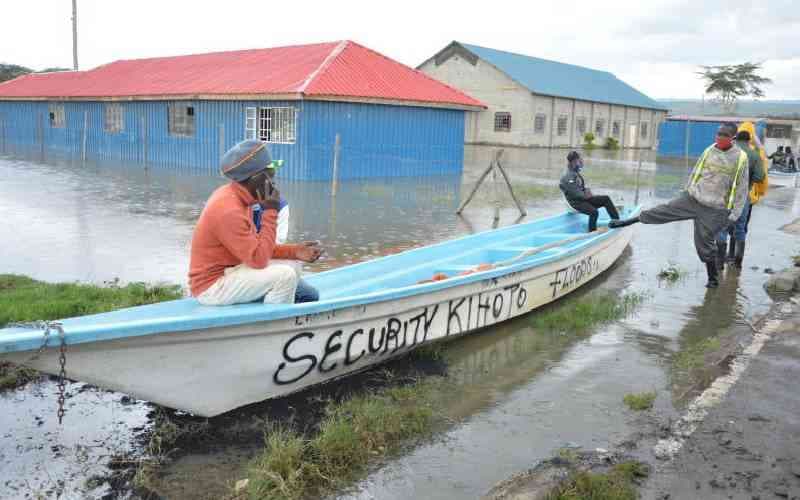Loading News Article...
We're loading the full news article for you. This includes the article content, images, author information, and related articles.
We're loading the full news article for you. This includes the article content, images, author information, and related articles.
Nearly 1,000 families have been displaced in Naivasha after Lake Naivasha overflowed and a key irrigation canal ruptured, flooding entire neighborhoods. Homes, a school and a church are underwater as officials warn of disease risks

Naivasha — More than 1,000 families have been displaced in Naivasha after Lake Naivasha’s water level surged and an irrigation canal burst its banks, flooding homes, schools, and farms in Kihoto estate and surrounding areas. The devastation, unfolding over the past week, has left neighborhoods submerged and officials warning of worsening conditions if the heavy rains persist.
In Kihoto estate, one of the worst-hit areas, residents have resorted to using boats to access marooned houses as roads turned into waterways. Entire families have abandoned their properties, while others remain trapped, waiting for evacuation support.
“The flood came so fast, unlike past years when the water rose gradually and gave us time to move,” said Nancy Nafula, a mother of three now taking refuge at a temporary shelter. Her story mirrors the plight of many who ignored earlier government evacuation notices because they had nowhere else to go.
The government had warned weeks earlier that residents on the riparian land faced imminent danger, but with limited relocation options, thousands stayed behind. The sudden surge overwhelmed them, with floodwaters seeping into boreholes and latrines, raising fears of cholera and other waterborne disease outbreaks.
Local officials have mobilized emergency services, but relief efforts are hampered by inaccessible roads and the sheer scale of displacement. Temporary shelters are filling quickly, and humanitarian agencies are appealing for food, clean water, and medical supplies to stave off secondary crises.
Authorities caution that more flooding could occur as meteorologists predict sustained heavy rainfall in the Rift Valley region. Disaster response teams are on high alert, but logistical challenges remain acute.
The disaster is not confined to Naivasha. In Siaya County, western Kenya, flash floods swept through Nyadorera location after part of the Lower Nzoia Irrigation Canal collapsed around 1 a.m. Villagers in Sidundo fled in darkness as floodwaters surged into their homes.
Local leaders attributed the devastation to clogged drainage systems that made it impossible to contain the overflow. They are calling for urgent intervention to repair broken dikes and restore the canal’s integrity to prevent repeat incidents. “We need immediate government support not only for relief but also for infrastructure fixes to protect communities,” one Siaya official urged.
Kenya’s vulnerability to seasonal floods continues to expose the shortcomings of disaster preparedness. Experts warn that riparian settlements, poor drainage infrastructure, and delayed response mechanisms exacerbate the human toll when extreme weather strikes.
Despite repeated government appeals for residents in high-risk zones to relocate to safer ground, economic realities often leave families with no alternatives. With meteorological forecasts indicating more rain, authorities face a race against time to mitigate further displacement and loss.
For Naivasha’s displaced families, the future is uncertain. Many remain in temporary shelters with limited supplies, while others cling to waterlogged homes in hopes of recovery. Health officials are prioritizing sanitation and vaccination campaigns to avert outbreaks of cholera, dysentery, and malaria.
The dual crises in Naivasha and Siaya underscore the urgency of long-term flood management strategies—ranging from stricter enforcement of riparian land laws to improved irrigation infrastructure and climate-resilient housing. Unless addressed, experts warn, floods will continue to devastate lives and erode livelihoods in Kenya’s most vulnerable communities.
Keep the conversation in one place—threads here stay linked to the story and in the forums.
Other hot threads
E-sports and Gaming Community in Kenya
Active 6 months ago
Popular Recreational Activities Across Counties
Active 6 months ago
Investing in Youth Sports Development Programs
Active 6 months ago
The Role of Technology in Modern Agriculture (AgriTech)
Active 6 months ago